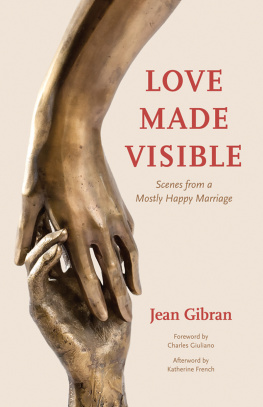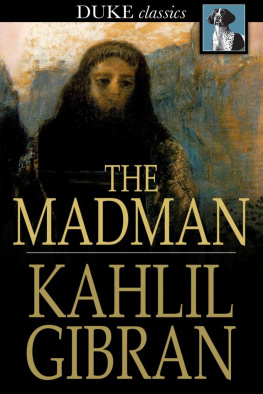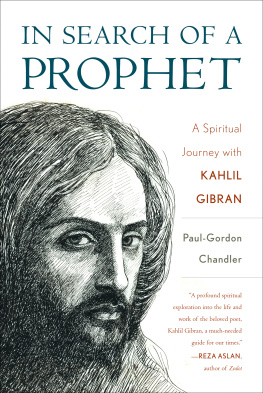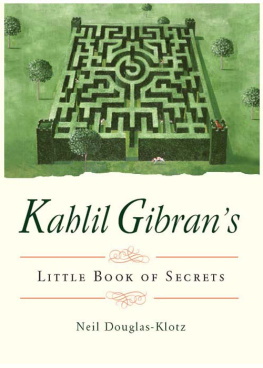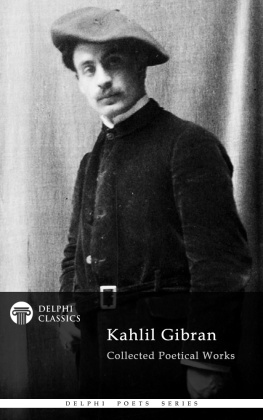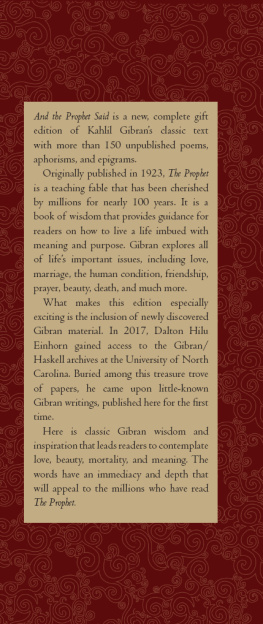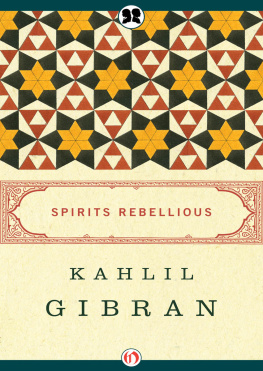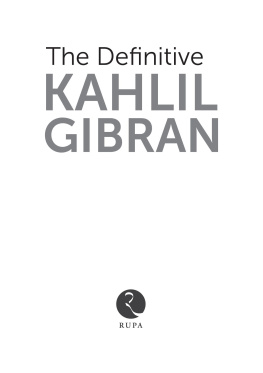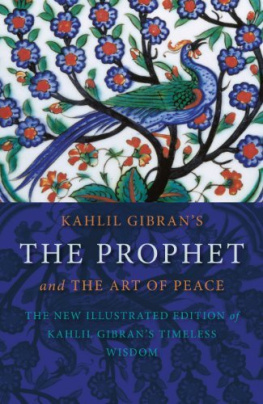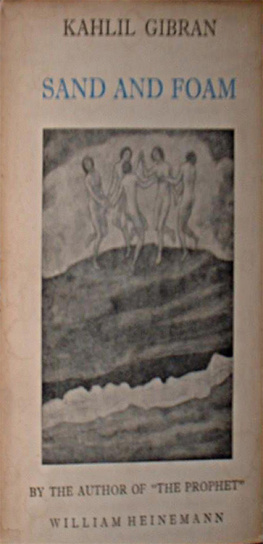Love Made Visible
First published in 2014 by
INTERLINK BOOKS
An imprint of Interlink Publishing Group, Inc.
46 Crosby Street, Northampton, Massachusetts 01060
www.interlinkbooks.com
Text copyright Jean Gibran 2014
Photographs the estate of Kahlil Gibran except where noted in captions.
Foreword copyright Charles Giuliano, 2014
Afterword copyright Katherine French 2014
Front cover photo by George Lynde (Joined Hands by Kahlil Gibran)
Back cover photo by Dennis Ditelberg (Jean Gibran and Kahlil Gibran,
Montreal, 1979)
See page 214 for additional credits.
All rights reserved. No part of this book may be reproduced, stored in a retrievalsystem or transmitted, in any format by any means, electronic, electrostatic,magnetic tape, mechanical, photocopying, recording, or therwise without theprior permissin in writing of the publisher.
Library of Congress Cataloging-in-Publication Data
Gibran, Jean.
Love made visible : scenes from a mostly happy marriage / by Jean Gibran. -
First edition.
pages cm
ISBN 978-1-56656-978-1
1. Gibran, Kahlil, 1922-2008. 2. Artists--United States--Biography. 3. ArabAmerican artists--United States--Biography. 4. Gibran, Jean. 5. Artists' spouses--United States--Biography. I. Title.
N6537.G443G53 2014
730.92--dc23
[B]
2014003265
Cover design by James McDonald | Impress Inc.
Book design by Pam Fontes-May
Printed and bound in the United States of America
Contents
Foreword by Charles Giuliano
I t was June of 1956. Then sixteen, I was enthralled by the Boston Art Festival installed in a series of tents on the manicured Boston Public Gardens. In particular, I was floored by the sculpture of Kahlil Gibran.
The Institute of Contemporary Art was difficult to reach by public transportation on Soldiers Field Road in Brighton. This effort was rewarded by a still vivid encounter with the first American museum exhibition of the Austrian expressionist Egon Schiele.
For me a youngster just becoming aware of art, there was palpable excitement visiting the festival. In addition to exhibiting fine arts, there was a stage for live performances. I recall jazz by the renowned Boston baritone sax player, Serge Chaloff, a play by William Saroyan, and a solo ballet performance by Maria Tallchief. This ambitious annual festival (19551964) organized by Nelson Aldrich ended through a lack of funding. It was revived once but marred by the theft of a painting by Barney Rubenstein because of a lack of security.
There were prizes awarded by jurors of the BAF resulting in debates and controversy. This focused on a perceived dichotomy between traditional still life and landscape works and more progressive forms of abstraction. Visitors voted for a Popular Prize.
In 1956 that was awarded to Kahlil Gibran for a nearly seven-foot, welded metal sculpture of Saint John the Baptist. It stunned and amazed me. With limited experience, it was the greatest work of art I had seen. Much has changed since then, but that galvanic sculpture continues to hold its place in my inner sanctum of all-time greatest hits.
Long before my encounters with the illustrations of Vitruvius, dissections of Leonardo da Vinci, or Grays Anatomy , that sculpture evoked a visceral response. With thin rods following the contours of muscles, it was as if Gibran had skinned the prophet, the better to reveal suffering and religious ecstasy.
So taken by this work, I never imagined that I would come to know the artist. Or eventually write an introduction to this book by his widow, Jean English Gibran.
Frankly, this memoir is not the book that I anticipated. As a trained art historian and critic, I expected an orderly, well-documented biography. But there are other ways a book can lead to further research of this lost generation of Boston artists, can be a step toward giving this particular Gibran and his peers their rightful place in the history of postwar American art.
There is a perfect storm of reasons why these artists have languished in a stagnant backwater of provincialism compared to the titanic epic of what Irving Sandler has dubbed the triumph of American art. There has been no such luck for Boston artists, whose efforts in the American art world have signified scattered and Pyrrhic victories.
Looking back to the 1950s, there were few opportunities to see works by leading contemporary Boston artists in a museum setting. Despite an ambitious new director, Perry T. Rathbone, who was intent on making the MFA more progressive, that did not extend to embracing the predominantly Jewish Boston Expressionists. In the traditional Brahmin arts community, there were unmistakable aspects of racism and anti- Semitism.
While Rathbone collected modern European art, particularly examples of expressionism, he showed little or no interest in Boston Expressionism. Unlike the directors who followed, Rathbone exhibited and collected modern art, but underwhelmingly.
The position of the MFA regarding modern and contemporary art was established by the renowned curator of Asiatic art Ananda Kentish Coomaraswamy (18771947), a Ceylonese philosopher and curator of Tamil and British origin who would have a key influence on young artists. But the museum was only interested in deceased artists with established reputations.
Major works by the leading Boston Expressionists Hyman Bloom and Karl Zerbe came to the MFA much later as part of the Lane Collection of American art and photography. Even today, the museum owns only a minor work by Jack Levine, who as a teenager with Bloom was nurtured by the Federal Works Progress Administration, a crucial player in its support of young artists. Both Bloom and Levine also were tutored by Harvard professor Denman Ross. He collected their juvenilia, later donated to the Fogg Art Museum. It languishes in storage and may be viewed by appointment.
Other than the occasional Brahmin Boston artist, like Jan Cox (19191980) of the Museum School, Rathbone kept his distance from local artists. The postwar era marked a sea change for the Boston art world.
Arguably, the decade between 1940 and 1950 represents a paradigm shift for Boston on every level, from social and economic to aesthetic. The faculty and focus of the School of the Museum of Fine Arts changed from polite and innocuous, ersatz American Impressionism to gritty and graphic Boston Expressionism. The old guard and its socially acceptable artists showed with the Copley Society or the Guild of Boston Artists. The work of the young Turks, Jews, and immigrants or their sonslike the Lebanese-American Gibranshowed with gallerist Boris Mirski or his former assistants Hyman Swetzoff and Alan Fink of Alpha Gallery.
Only in the past few years has the Institute of Contemporary Art decided to collect. Gibran and his peers showed with the ICA particularly early on, like a 1947 Boston Institute of Modern Art group show. Work by the young Gibran was singled out for praise by the citys leading critic, Dorothy Adlow, in the Christian Science Monitor .
The global status of Boston in the field of modern and contemporary art would be entirely different if the ICA had collected from its beginning. During the 1950s, Thomas Messer of the ICA advised the MFA on some remarkable acquisitions. There was a plan to merge the ICA with the MFA, hiring Messer as its curator. It was deemed that the institutions should not compete (still true), and Messer decamped for New York.
The DeCordova Museum and Sculpture Park, in Lincoln, Massachusetts, has long been dedicated to the artists of New England. There were major surveysExpressionism in Boston, 19451985; Painting in Boston, 19502000 (20022003); and Photography in Boston: 19551985 (2001). While invaluable resources for research, these efforts were flawed by flagrant omissions, such as Gibran, and a general lack of curatorial or critical acumen.

